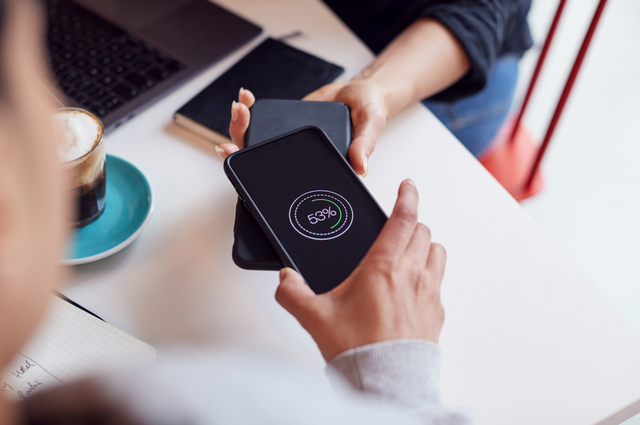Wireless charging has become a must-have feature in both iPhones and high-end Androids, but very few know about the core technology that powers it. So what is wireless charging, what are its benefits (advantages), drawbacks (disadvantages), and how does it work in modern consumer gadgets? Here, we will tell you everything about it and what you need to know before you buy your next high-end smartphone, smartwatch or earphones. We will also tell you about how it’s being used in the industrial sector and how continuing advancements in the technology could one day allow devices to be even charged remotely.
Wireless Charging: What it is and How it Works
Wireless charging has been available in Android smartphones for years, but it really caught the attention of the mainstream media globally after Apple introduced it in its iPhone X and iPhone 8-series in 2017. It has since expanded to all high-end iPhones like the iPhone 12 series, and even some mid-range smartphones, like the iPhone SE (2020), and is expected to become more mainstream in the coming years. So it’s about time we knew more about the technology and how it works. In this article, will also tell you about its origins and the various types of wireless charging tech in use these days.
What is Wireless Charging?
Wireless charging is the transfer of energy from a transmitter device to a receiver device via electromagnetic induction instead of using wires as a physical link. Also known as inductive charging, the process involves the production of an electromotive force across an electrical conductor in a changing magnetic field to provide electricity to a battery, often inside an electronic gadget. The charging takes place through an inductive transmission pad instead of a wired connector.

How Does Wireless Charging Work?
Inductive charging generates power by passing an electrical current between two coils to create an electromagnetic field. The primary coil in the charger induces a current in the secondary coil, which resides in the device being charged. Energy is transferred from the charging device to the receiving device through inductive coupling. The process involves the running of an alternating current (AC) through an induction coil in the charging pad, creating a magnetic field, which fluctuates in strength as the AC current continually changes its amplitude.

The time-varying electromagnetic field generates an electromotive force, thereby creating an alternating electric current in the induction coil in the receiver device. It is then converted to direct current (DC) with a rectifier and used to charge electromagnetic cells, like batteries in smartphones, smartwatches, earphones and other receiver devices. While the energy transfer from one coil to another is technically without wires, the charging pad still needs to draw power from an electric source using a wired connection in most cases.
What is Reverse Wireless Charging and Which Phones Support it?
Reverse wireless charging allows a device to use its battery power to charge another device. It uses the same principles of electromagnetic induction, but this time around, the coil in the smartphone acts as the transmitter instead of the receiver. Some of the leading smartphones that support reverse wireless charging include the Samsung Galaxy S21-series, Galaxy S20-series, the Huawei P30 Pro, Mate 30 Pro, etc.

Benefits (Advantages) of Wireless Charging
The benefits of wireless charging are manifold. The first and foremost benefit is convenience. It is convenient to drop your phone on the wireless charging pad instead of having to fiddle around trying to insert a jack into a port. Secondly, it is also a relatively safe way to transfer power to your phone, because it doesn’t require you to physically touch the electric socket every time you want to charge a device. Finally, it reduces wear-and-tear on the device by doing away with the need to plug it in and out every time.
Drawbacks (Disadvantages) of Wireless Charging
The biggest disadvantage of wireless charging is that it is a wasteful technology. In its current state, wireless charging is highly inefficient and consumes between 39% and 80% more energy than its wired equivalent. A large amount of the energy is lost as heat, with the exact efficiency depending on the design of the charger. The loss is even more pronounced when the coils in the phone aren’t aligned properly with the coils in the charging pad.
While many users may be willing to swap efficiency for convenience, it might have a major impact on the environment if wireless chargers become the primary method of charging electronics gadgets and gizmos.
Another fallout of the inefficiency is the charging speed. Wireless charging is painfully slow when compared to wired charging, especially when manufacturers are unleashing super-fast wired charging technologies. What’s more, while you can still use your phone while charging it with a cable, wireless charging, at least in its present form, will stop entirely the moment your take it off the charging pad. That is poised to change soon, but more on that later.

Finally, wireless charging pads are not available at all airport terminals, railway stations, hospital lobbies, and other public places. That means if you run out of juice and don’t have a cable, you might be in for a shock. As things stand now, wireless charging is more form-over-function. That said, researchers are working furiously to rectify some of the aforementioned issues, so we can expect more efficient wireless charging solutions going forward.
Different Wireless Charging Standards
There are two major competing organizations that specify inductive and resonance charging standards, and both have their share of supporters. The more well-known one is the Wireless Power Consortium (WPC), which counts Apple, Google and Xiaomi among its members, while the AirFuel Alliance includes the likes of Dell, Duracell, Gan systems and more. Many companies, like Samsung and Huawei, are members of both organizations.
The WPC develops and regulates the most popular wireless charging standard, Qi (pronounced ‘chee’), which is used by most smartphone manufacturers, including Apple, Samsung, Xiaomi etc. AirFuel, on the other hand, is tying up with airports, hotels, and cafes in Europe, as well as large restaurant chains like MacDonald’s and coffee shops like Starbucks in the US, to roll out wireless charging stations at public spaces. This, many believe, might eventually help wireless charging gain wider adoption.
Origins and Advancements
The concept of wireless charging was first demonstrated by the redoubtable Nikola Tesla, who discovered the phenomenon of magnetic resonant coupling in the late 19th century. However, for the best part of the next century, the technology couldn’t be put to any real-life use except for a few electric toothbrushes and other small gadgets.
Cut to the twenty-first century, the technology has well and truly started entering the consciousness of mainstream consumers, thanks to its adoption by smartphone manufactures. In what could be a game changer for the industry, technological advancements in the sector could also soon enable some IoT devices to get power even when they are placed several feet away from a charger.
Different Wireless Charging Technologies
Most of the wireless charging standards currently in use rely on three major techniques. Firstly, there’s tightly-coupled electromagnetic inductive or non-radiative charging, which requires the transmitter and the receiver to be in contact with each other for the energy transfer. Next, there’s the loosely-coupled or radiative electromagnetic resonant charging that can transmit a charge over very short distances, like a few inches. Finally, there’s uncoupled radio frequency (RF) wireless charging that can transfer energy several feet away, although, at a very slow speed.
Remote Wireless Charging
One of the major disadvantages or drawbacks of wireless charging is that you can’t really use the device while it is being charged. However, many companies are now working on remote wireless charging technologies that could help users finally cut the cord for good. It all started in 2007, when a team of MIT researchers, led by physics professor Marin Soljačić, demonstrated the ability to power a 60 watt light bulb wirelessly from a distance of around two meters (~6.5 feet).
While the technology was supremely inefficient back then (~45% efficiency), it has since advanced by leaps and bounds, and can now transmit high levels of power (up to 11kW) at an efficiency of up to 92%.
The near-field wireless power transfer technology system was originally put to commercial use by Soljačić himself, who in 2017, founded a company called WiTricity, which designs remote wireless charging systems for electric vehicles. Other companies, like Ossia and Energous, have demonstrated wireless charging from up to a distance of 30 feet, although, the efficiency reduces drastically with the increase in distance.
With wireless charging becoming more mainstream, even remote wireless charging is seemingly set to hit consumer electronics sooner rather than later. Xiaomi last month announced a remote wireless charging technology called ‘Mi Air Charge’ that can charge multiple device simultaneously while you’re gaming, walking around or even when something’s in the way.
It is a 5W charger that uses 144 antennas in the base station to send millimeter-wide waves to receiving devices. As of early February, there’s no word on when the device will hit the market.

Application in IoT, Healthcare and Automotive Industries
While WiTriCity is bringing wireless charging to automobiles, other companies from around the world are incorporating the technology in other industries, including healthcare, robotics, and more. The auto industry, however, remains one of the biggest patrons of the technology.
Dozens of automobile models now offer Qi-based wireless charging in their cabins, while many electric vehicles, like the Mercedes Benz S550e, can charge wirelessly by simply parking over a charging pad. In the future, vehicles might even get charged while in motion, thanks to a technology called dynamic electric vehicle charging (DEVC).
With wireless charging and its benefits reaching beyond the confines of the consumer electronics sector, experts predict that it can be used in medical implant devices like cardiac pacemakers and other cardiac assist pumps. In 2018, the Massachusetts Institute of Technology (MIT) demoed a system called In Vivo Networking (IVN) that allows medical devices implanted inside the human body to operate while getting power from radio waves externally.
The invention paves the way for even more powerful implantable devices and microscopic embedded sensors. Possible use cases include implantable hardware to monitor blood sugar levels and other critical parameters.
With the scope and scale of wireless charging continuing to increase, future use cases for the technology may also include other innovative applications, like restaurant tables that double up as a charging pad for smartphones, furniture with integrated wireless charging, and kitchen counters that power toasters, grinders and other appliances wirelessly. The increased benefits and applications are also likely to improve adoption of wireless charging, but it’s not immediately clear as to when that would happen.
Smartphones With Wireless Charging
In 2009, the Palm Pre became the first commercially-available smartphone to offer wireless charging. Since then, dozens of devices have adopted the feature, including the Droid Charge in 2011 and the Nokia Lumia 920 in 2012. Today, there are many smartphone models that offer the benefits of wireless charging. Some of the latest smartphones to offer the feature include:
- Samsung galaxy S21 series
- iPhone 12 series
- Google Pixel 5
- Galaxy Note 21 series
- OnePlus 8 Pro
Best Wireless Chargers
There are many wireless chargers available in the market, and most of them adhere to the Qi standard for maximum compatibility. Here, we are listing some of the best that you can buy right now:
- Apple MagSafe Charger (certified for select Apple devices): ($39)
- Samsung 15W Wireless Charger: ($79.99)
- Anker PowerWave Alloy: ($29.99)
- RAVPower Wireless Charger: ($22.99)
- Philips Fabric Wireless Charger: ($19.88)
What is Apple MagSafe Charging? Difference Between Magsafe and Qi
Introduced alongside the iPhone 12, MagSafe is an improved version of Apple’s existing wireless charging technology and offers additional benefits. It is still based on the Qi charging technology at its core, and as such, is compatible with Qi chargers. However, what MagSafe does differently, is that it helps in correctly aligning the smartphone with the charger for a faster and more efficient charging process.

To achieve better alignment for its MagSafe technology, Apple added rings of magnets around the iPhone’s charging coil to help the device snap in place when placed on the charging mat. Apple also improved the charging speed with MagSafe in the iPhone 12 series, which now offers up to 15W instead of the 7.5W on the earlier models.
Apple’s MagSafe charger is certified to work with select Apple devices, including, but not limited to, the iPhone 12 series, the Apple Watch and the AirPods Pro. However, it has been proven to be compatible with a number of Android smartphones, including the Google Pixel 5, the Samsung Galaxy Z Fold 2, Galaxy Note 10 series, and more. That’s not surprising, given that Apple also adopted the WPC’s Qi charging standard for its MagSafe technology. Similarly, iPhones with wireless charging support (MagSafe or otherwise), can be charged using any existing Qi charging mat.
You can also check out our detailed list of the best wireless chargers and the best MagSafe wireless charging car mounts for the iPhone 12 series.
Frequently Asked Questions
-
How do I know if my device can charge wirelessly?
To know whether your phone, watch, or earbuds support the feature, check out the user manual that you got with the retail box. Given that wireless charging is one of the highlight features in any device, it will be mentioned rather prominently if applicable. Also check out the vendor’s website and search the web to know more about your device’s features and functionality.
Do note that as of now, all phones that support wireless charging can still be charged with cables as usual. However, that might change, with reports suggesting that Apple might be planning to do away with ports altogether in future iPhones, although, that might still be some way away.
-
Can I charge a smartphone in its case, or do I need a special case?
Most polycarbonate and TPU cases, whether clear or otherwise, will let you charge your phone wirelessly. Thicker ‘rugged’ cases are exceptions to the rule. So if your phone supports the feature and you plan to make use of it, make sure you buy a case that is clearly marked as compatible.
-
How do I set up wireless charging?
Buy a compatible wireless charger and plug it into a wall socket using the power adapter that came with your accessory or one that’s recommended by the manufacturer. Once the charging mat is drawing power, place your phone on it with the display facing up. For best performance, place it in the center of the charger. In case of dual- or triple-charging mats, place the phone or other devices at the exact location recommended by the manufacturer.
-
Can I get wireless charging in my car?
Many cars come with factory-installed charging stations. Even if your car doesn’t come with one, you can still easily add an aftermarket wireless charger for automobiles. Make sure to buy the right specification for your device. Also, ensure that both the charger and the device you’re trying to charge adhere to the same charging standard. Go through this article in full detail to know more.
-
Does wireless charging heat up the phone?
Heating typically happens because of inefficiency in power transfer, so the more efficient your charging pad is, the less hot your phone will be. That said, wireless charging is inefficient by nature, so there’s always going to be some excess heat. As long as both the phone and the charging mat adhere to established standards, you need not worry about a repeat of the Galaxy Note 7 fiasco.
-
Is wireless charging faster than cable charging (benefits, if any)?
As mentioned already, wireless charging is painfully slow when compared to wired charging. It’s another fallout of the inefficiency in transferring power wirelessly. So yes, wireless charging is slower, it heats up your device and doesn’t let you use your phone freely while getting charged. Things are changing with remote wireless charging and other new innovations, but it will likely continue to lag behind wired charging in terms of speed and efficiency in the forseeable future.
The Future of Charging Technology is Here
Scientists believe that they have only scratched the surface of what wireless charging technology has to offer. In the coming years, as the technology matures, it will offer more both in terms of its scope and performance. Till then, it will mostly remain a relatively niche feature as a desirable, but non-critical function in consumer gadgets like phones, watches and earbuds. Either way, now that you know so much about wireless charging, its benefits (advantages), and its drawbacks (disadvantages), let us know if it is a must-have in your next smartphone or if you still feel that it is a gimmick that’s still not ready for primetime.









